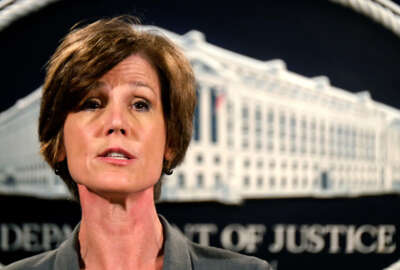
Hiring freeze promotes creativity
Is the bureaucratic version of climate change taking chunks out of the federal hiring freeze?
Unless they went to the Bernie Madoff School of Money Management, most investment gurus advise clients that past performance (as in the stock market) is no guarantee of future performance or results. In other words, what goes up can, does and will go down at some point. Then up again. Then down again. Kind of like life in the federal workforce.
It is not unusual for an incoming president to slap a freeze on federal hiring until he and his team get a handle on the federal bureaucracy. Jimmy Carter and Ronald Reagan did it. Now the Trump administration has frozen civilian hiring until the Office of Management and Budget comes up with a long-range attrition plan for the government. Like X-number of workers can be hired for every Y-number who leave. As with most operations on a giant-scale, like the federal government, the devil is always in the details. What starts out as a solid freeze quickly falls apart as the new team implementing it learns — some apparently for the first time — that there are certain government agencies, functions and jobs you can’t allow remain empty when the incumbent quits, retires or dies. Which is where creativity can come into play on a large or small scale. How creative depends on the daring of agency officials and their mission. And, of course, the goal. For example:
As with most operations on a giant-scale, like the federal government, the devil is always in the details. What starts out as a solid freeze quickly falls apart as the new team implementing it learns — some apparently for the first time — that there are certain government agencies, functions and jobs you can’t allow to remain empty when the incumbent quits, retires or dies. Which is where creativity can come into play on a large or small scale. How creative depends on the daring of agency officials and their mission. And, of course, the goal. For example:
In 1980, Congress decided that there were too many supervisors in government supervising too few employees. It was considered wasteful and costly. Why pay somebody relatively big bucks to supervise six workers when in the private sector the ratio would be 1 to 12? Or whatever?
The government swung into action as only the government can swing into action. The (then) General Accountability Office did its usual exhaustive study which it said was hampered by the fact that “the usefulness of aggregate data such as supervisor to nonsupervisory (in government and the private sector) is very limited. There are many legitimate factors which determine what an appropriate level of supervision should be for an organization or function. Comparing aggregate ratios such as supervisor to nonsupervisory ratios serves only to identify what needs to be looked at in more detail.” And so on, and so on. OK!
Other studies were made, reports written. One conclusion was that the situation would improve when the government adopted a new workforce planning system that would improve manpower management.
In 1992, the Merit Systems Protection Board took a 24-page swipe at the issue, from a slightly different angle. Its report, called As Supervisors Retire, said agencies should better identify supervisors and their duties, train supervisors better, “reevaluate the best mix of supervisor to nonsupervisory” and do a better job of training supervisors. And of giving them time to supervise.
Meantime the long-suffering career establishment came up with the solution. A number of bold officials, and often their subordinates, solved the problem. They changed the job titles of many “supervisors.” They kept the same duties and continued to manage people, but not as official supervisors. Then agencies would report to Congress that their ratio of supervisor to supervised had been corrected. Problem solved.
Long-time fed watchers predict something like the supervisor fix will be applied — across the board —to the freeze. It started out with a long list of exemptions (agencies, programs and specific jobs) and that has been growing since the freeze started.
The above list of things exempt from the freeze was quickly followed by what was described as a “sweeping set of (16) exemptions” at the Defense Department to the governmentwide hiring freeze.
A 30-year, now retired, veteran of the HR side of government said things like the supervisor vs. worker bee issue, or hiring freezes, “always brings out the creativity of federal managers.”
He said it reminded him of the time back when fur coats were allegedly desired by most American women. Mink was top of the line, but expensive. So some were made out of skunks but clever marketers knew that wouldn’t do. “So they called the coats Woodland Kitty.” Same thing in Washington, he said, “just a different market.”
Nearly Useless Factoid
Pepé Le Pew made his first appearance in Jan. 6, 1945, Warner Bros. cartoon, “Odor-able Kitty.”
Source: Wikipedia
Copyright © 2024 Federal News Network. All rights reserved. This website is not intended for users located within the European Economic Area.
Mike Causey is senior correspondent for Federal News Network and writes his daily Federal Report column on federal employees’ pay, benefits and retirement.
Follow @mcauseyWFED





